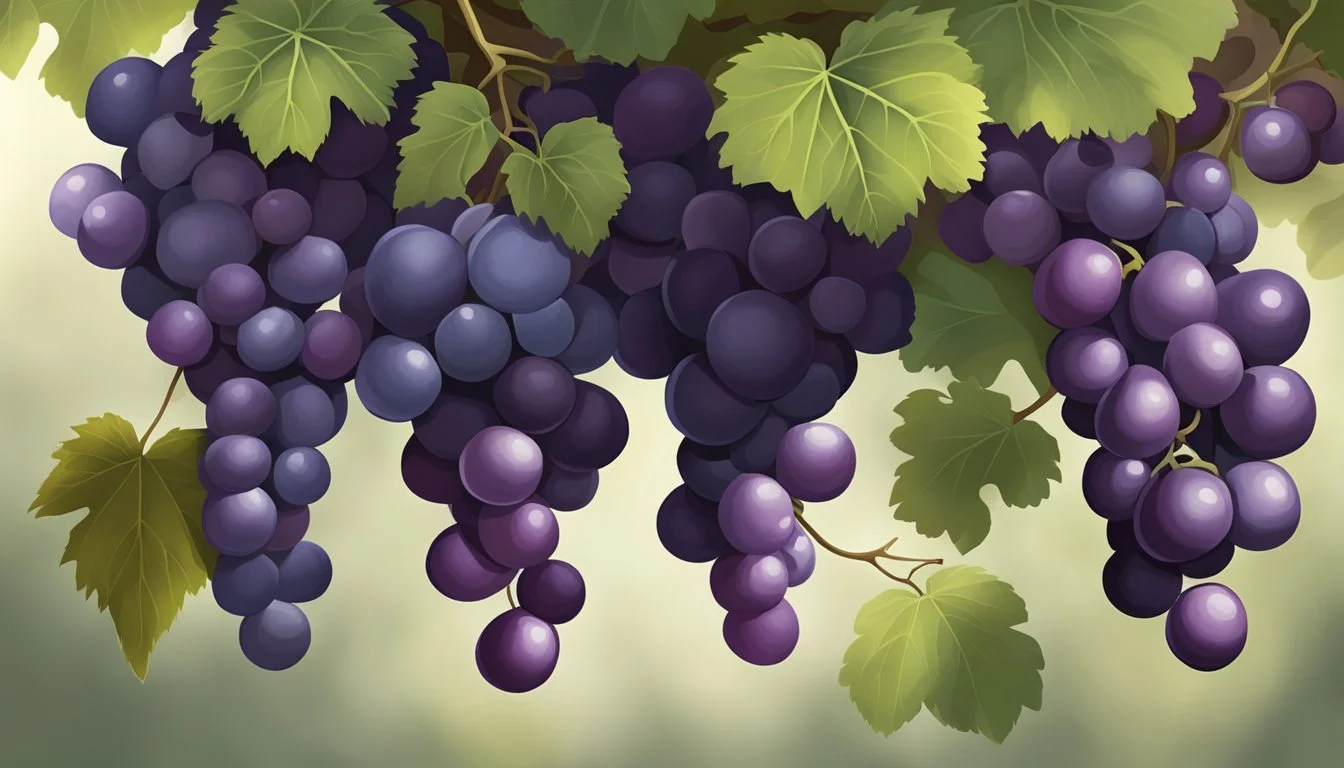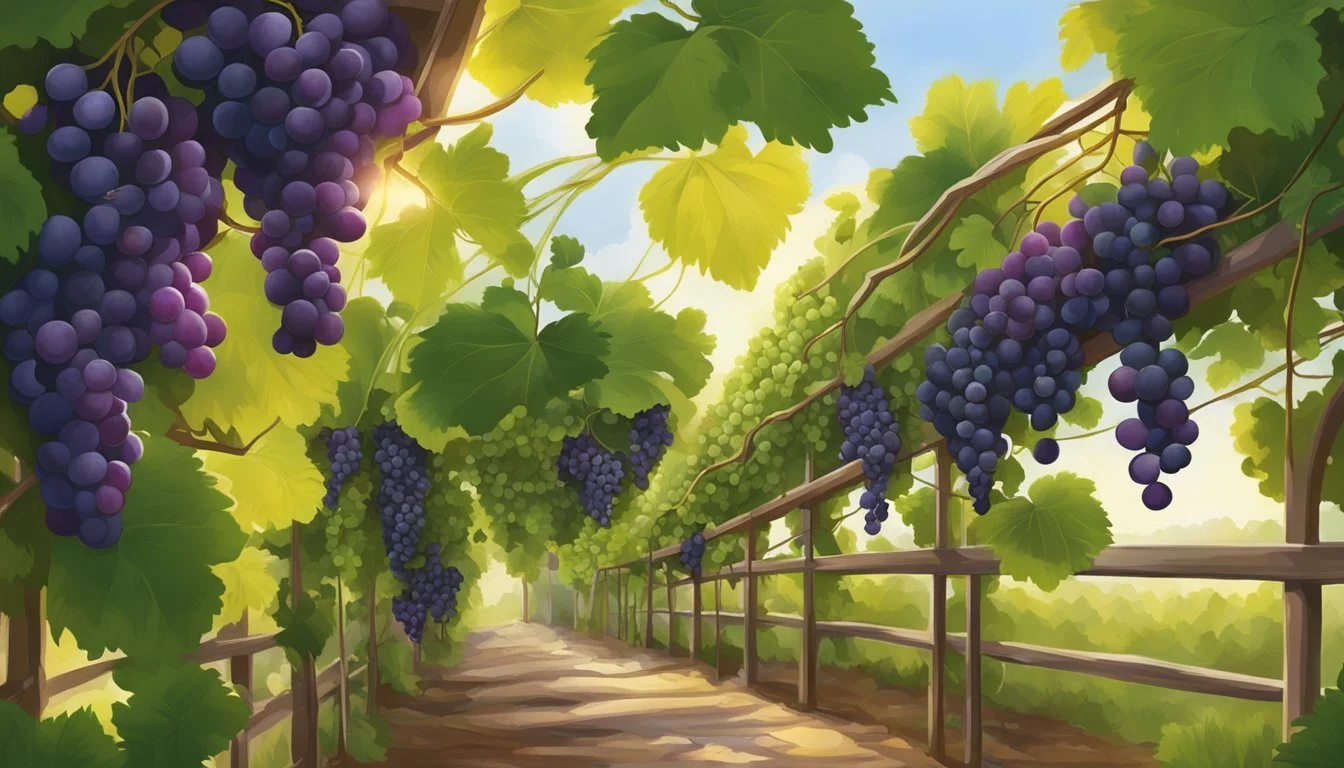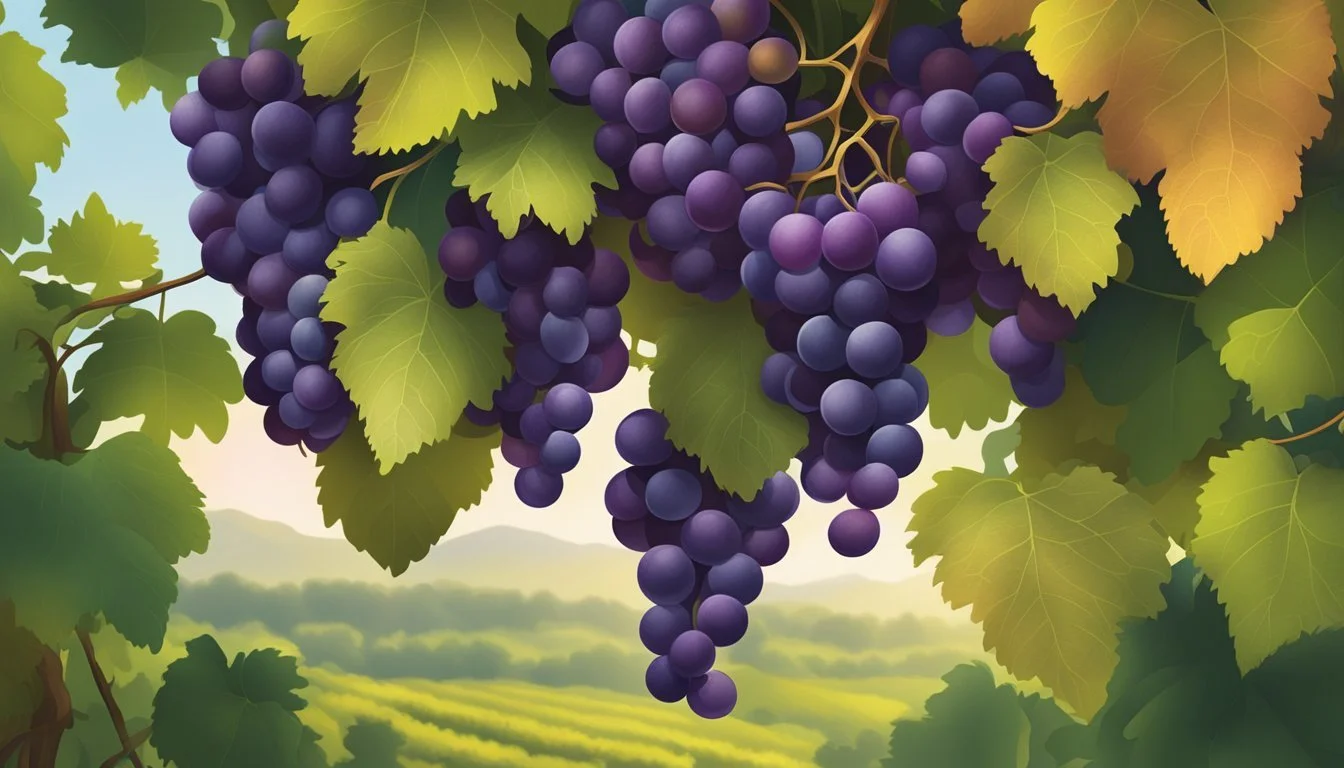How to Tell if Muscadine Grapes Are Ripe
Your Ultimate Ripeness Checklist
Muscadine grapes, native to the southeastern United States, are a seasonal delicacy savored for their rich flavor and numerous health benefits. Knowing when these grapes have reached peak ripeness is key for both commercial growers and home gardeners. Ripe muscadine grapes offer the best taste and nutritional value, but harvesting them at the right time can be a challenge, as the window for peak ripeness is often narrow.
The ripening of muscadine grapes can be monitored through changes in color, texture, and taste. As they mature, their color transitions from green to shades of red, bronze, or purple, depending on the variety. Ripe muscadines are not only a visual treat but also delight the palate being soft, juicy, and sweet with reduced acidity. Growers can use this sensory data—along with tools such as refractometers to measure sugar content—as reliable indicators to determine the precise moment for harvesting.
Key Takeaways
Ripeness in muscadine grapes is indicated by color changes, soft texture, and sweet flavor.
Harvesting should occur when grapes show peak ripeness indicators to optimize flavor and quality.
Appropriate tools and sensory evaluation are essential in determining the perfect harvest time for muscadine grapes.
Identifying the Characteristics of Muscadine Grapes
Muscadine grapes are a distinctive species known for their unique properties and appearance. They can be identified by their signature round shape and the shiny texture of their flesh. These grapes commonly exhibit a variety of colors ranging from green in their unripe state to bronze, purple, or even a deep black as they mature. The color transformation often indicates the ripening stage.
The flavor profile of muscadine grapes is notably robust and complex, departing from the simpler sweetness of conventional table grapes. One will find muscadine grapes encompass a broad spectrum of cultivars, each with its own nuances in taste and texture. Some popular varieties include:
Ison: Typically black in color and known for its sweet taste.
Fry: Often a bronze cultivar with a pleasing flavor.
Noble: Usually purple, favored for making wine due to its hearty skin.
Alachua: A black variety recognized for its high yields and quality.
Triumph: Produces large bronze berries and has a vigorous vine.
Supreme: Known for very large, black berries and intense flavor.
Black Beauty: Appreciated for its sizable, black fruit.
Cowart: A reliable purple cultivar valued for its disease resistance.
The texture of muscadine grapes is also a distinguishing factor. They possess tough, tannic skins, which contrast sharply with the softer flesh of other grapes, and often contain seeds. Muscadines are a testament to the diverse viticulture landscape, widely appreciated in the southeast United States and beyond for their resilience and the flavorful contribution to the fruit and wine industry.
Optimal Conditions for Muscadine Grape Ripening
Achieving the fullest flavor in muscadine grapes is directly tied to the environment they grow in. Certain climatic conditions, soil types, and vineyard management practices are crucial throughout the ripening process.
Climate and Sunlight Requirements
Muscadine grapes thrive in warm, humid climates, typically in the southeastern United States. They require a long growing season with temperatures ranging from 75°F to 85°F during the day. Full sunlight is essential, as vines need to be exposed to at least six hours of direct sunlight per day. This light exposure is particularly important during the flowering phase through to the harvest months of late August to September.
Soil Type and Irrigation
The ideal soil for muscadine grapes is well-draining with a slightly acidic pH. Amending the soil with organic material can increase nutrient levels and improve structure. Consistent irrigation is important, but overwatering should be avoided, especially as the grapes begin to ripen, as it can dilute flavors and increase the risk of diseases like mold. As the weather cools in October and November, the irrigation needs will lessen.
Vineyard Care Through the Seasons
Proper pruning shapes the vine’s growth, ensuring it concentrates energy into fruitful production. Pruning during the dormant season before spring is crucial, as is training vines onto a trellis or cordon system to support robust growth. Pests and diseases, including powdery mildew, black rot, aphids, and mold, should be monitored and managed proactively. A grower's commitment to careful maintenance in and out of growing seasons is vital for optimal ripening.
Stages of Grape Development and Ripeness Indicators
Muscadine grapes undergo distinct developmental stages marked by observable changes. Identifying ripeness involves assessing various indicators from visual cues to chemical composition.
From Flowering to Veraison
Muscadine grapes begin their life cycle as flowers in late spring and progress through the growing season. Veraison is a critical phase occurring in late summer where grapes transition in color from green to shades of red or purple, signaling the onset of ripening. This stage is marked by the start of sugar accumulation and the softening of the berries.
Measuring Sugar Content and Acidity
The sugar content and acidity of muscadine grapes are indicative of their maturity and flavor balance. During early fall, full maturity is approached, and sugar levels rise as acidity diminishes. A refractometer is commonly used to measure the sugar content in the juice of the grapes, providing a Brix reading that indicates sweetness levels. Ideal ripeness typically corresponds with sugar content that satisfies the intended use of the grapes, whether for fresh consumption or wine production.
The Role of Taste Testing in Determining Ripeness
Taste testing remains an essential method for gauging the ripeness of muscadine grapes. Beyond technical measurements, the sensory experience of sweetness, flavor, and juiciness is critical. When grapes taste sweet and full-flavored without excess tartness, and feel juicy when bitten into, they are likely at peak ripeness. This subjective assessment complements scientific tools to inform harvest decisions.
Harvesting Muscadine Grapes
When it's time to harvest muscadine grapes, understanding the indicators of ripeness and employing the right techniques can ensure the best quality fruit. Proper handling and storage post-harvest are crucial to maintain the grapes' shelf life and flavor.
Determining the Harvest Time
Muscadine grapes typically reach ripeness in late summer to early fall. Indicators of ripe muscadine grapes include:
Color: The grapes transition from green to a deep purple or red for dark varieties, and bronze or golden for lighter ones. The full color change is a primary sign of maturity.
Sugar Content: Ripe muscadines have a sugar content that creates a balance between sweet and tart. A refractometer can be used to measure the Brix level, an indicator of sweetness.
Texture: Ripe grapes will be firm but give slightly under pressure, similar to a ripe plum.
Taste: A simple taste test can often confirm ripeness. The grape should taste sweet and full-flavored.
Recommended Harvesting Techniques
To harvest muscadine grapes, one must be gentle to avoid damaging the fruit:
By Hand: Grasp the berry and twist it gently. A ripe muscadine will come off the vine with a wet scar, indicating it’s ready and was picked without damage.
Picking Containers: Use shallow containers to prevent crushing the grapes under their own weight.
Mechanical Harvest: This method is typically used in commercial production where machines shake the vines, but it can affect the quality with more wet scar grapes.
Post-Harvest Handling and Storage
After harvest, careful handling is essential:
Immediate Cooling: To prolong shelf life, cool grapes swiftly to a temperature between 32°F and 50°F.
Storage: Keep muscadines in a refrigerator to reduce the risk of decay. They can last up to a week when stored properly.
For the Fresh Market: For selling at a grocery store or fresh market, grapes should look plump and be free from blemishes, ensuring they are appealing to consumers.
By following these steps, you can effectively harvest and handle muscadine grapes, ensuring they reach the consumer in the best possible condition.
Utilizing Ripe Muscadine Grapes
Muscadine grapes, once ripened, offer a rich palette of options for both culinary and health-focused applications. They are particularly noted for their high sugar levels and robust flavors, making them ideal for various processing methods and direct eating.
Making Wine and Juices
Muscadine grapes are a popular choice for winemaking due to their high sugar content and distinct flavor profile. Each grape variety can impart unique characteristics to the wine. For instance, bronze varieties tend to produce wine with a lighter, fruitier taste, while dark muscadines yield a richer, more intense flavor. The grapes should be pressed to extract the juice, and then fermentation can be initiated. Muscadine wine is not only a delicious beverage but also contains antioxidants beneficial to health.
When making juice, muscadine grapes can be processed in a juicer or blender. The resulting juice retains the grape's natural sweetness and can be enjoyed fresh or used as a base for beverages or cocktails.
Creating Jams, Jellies, and Preserves
Ripe muscadine grapes are also perfect for creating jams, jellies, and preserves. The natural pectin found in the skins and seeds of muscadines helps these spreads set without the need for additional pectin. The process involves cooking the grapes with sugar, which both preserves them and highlights their delicious flavor profile. Whether spread on toast or used as a glaze for meats, muscadine jams and jellies are a tasty way to enjoy the fruit all year round.
Jam typically includes crushed fruit, lending it a chunky texture.
Jelly is made from the juice of the grapes, resulting in a clear and firm set.
Preserves contain larger chunks of fruit, giving them a more varied texture.
Direct Consumption and Health Benefits
Consumers often enjoy muscadine grapes fresh due to their juicy nature and health benefits. As a nutritional powerhouse, these grapes are loaded with antioxidants that combat free radicals in the body. Muscadines can be consumed raw, straight off the vine, or chilled as a refreshing snack. Each specific variety of muscadine may offer a slightly different balance of sweetness, tartness, and flavor, allowing individuals to choose according to their taste preferences.
Advanced Topics for Growers and Enthusiasts
Muscadine grape cultivation extends beyond basic care into specialized strategies that improve vine health, fruit quality, and yield. Expert growers in America continuously adapt to climate and location specifics.
Cultivar Selection and Vine Management
Selecting the right muscadine grape cultivar is crucial for successful production. Cultivars such as 'Supreme' offer larger fruit and better disease resistance. Vine management practices, including pruning and training, directly influence yield and quality. For instance, the pruning method adopted can shape the vine architecture, which in turn affects sunlight exposure and air circulation. Growers should train the vines on a trellis system to optimize fruit production and facilitate irrigation.
Pest and Disease Management Strategies
Pest and disease management is a significant concern in grape production. Key pests like aphids and challenges such as powdery mildew and black rot can devastate crops. Integrated pest management (IPM) strategies that include regular inspections and the introduction of natural predators can mitigate these issues. Cultivars with innate disease resistance should be chosen whenever possible, and fungicide applications may be necessary when conditions favor disease development.
Techniques for Improving Grape Quality
Enhancing grape quality involves a multifaceted approach:
Climate Adaption: Matching the cultivar to the local climate can significantly impact fruit development.
Sunlight Maximization: Proper canopy management ensures adequate sunlight, which is vital for optimal fruit set and sugar accumulation.
Irrigation Practices: Precise water management improves berry size and texture.
Timely Harvesting: Determining the perfect harvest time is essential; it should align with the peak sugar content and low acidity, while avoiding overripeness.
By implementing advanced techniques in these areas, growers can achieve greater control over their muscadine grape production, leading to higher quality fruit and increased satisfaction for both the grower and the consumer.
Additional Resources
When researching the optimal time to harvest muscadine grapes, a selection of resources is available for individuals seeking detailed guidance.
NC State Extension: A comprehensive resource that offers insights on disease management and the maintenance of muscadine grape health is available through the NC State Extension. Their materials include:
Guides on muscadine diseases and their management
Lists of fungicides and their effectiveness
Disease identification through images and descriptions
North Carolina State University: For those seeking scientific studies and academic papers, NC State University provides valuable resources, including:
Research papers detailing the histopathology of diseases like Marophoma rot
Cultural and chemical management strategies for growing muscadine grapes
Online Platforms: Explorers of muscadine grape cultivation can also utilize various online platforms that provide practical insights:
Educational videos on muscadine ripeness indicators
Internet forums for discussions with experienced growers and viticulturists
Social media groups dedicated to muscadine grape enthusiasts
Publications: Books and guides are available for in-depth reading:
The Muscadine Grape Guide by Dr. Vineyard (fictional example)
Muscadine Seasons: From Vine to Wine by the American Vintners Association (fictional example)
Access to these supplemental resources can enhance growers' understanding of muscadine grape cultivation, ensuring a successful and bountiful harvest.
Conclusion
Determining the optimal ripeness of muscadine grapes is critical for achieving the best flavor and quality. Growers can rely on a few key indicators:
Color change: Berries transition from green to red or purple.
Texture: They soften as they mature.
Taste: Sweetness increases; tartness decreases.
Grape condition: Grapes should be free of infections like botrytis.
Harvesting typically occurs from late August to September in the United States. Timing can depend on factors like climate, variety, and purpose. For instance, grapes intended for wine may be picked at different sugar levels than those for fresh consumption. The use of tools like a refractometer can provide a more exact measure of sugar content.
It is also recommended to pick muscadine grapes in the cool, early morning hours to maintain their quality. Checking grapes regularly as they near the usual harvest time helps in identifying the perfect moment to pick them. By observing these signs, growers can confidently harvest muscadine grapes at their peak ripeness, ensuring the highest quality of the fruit for consumption or production.






